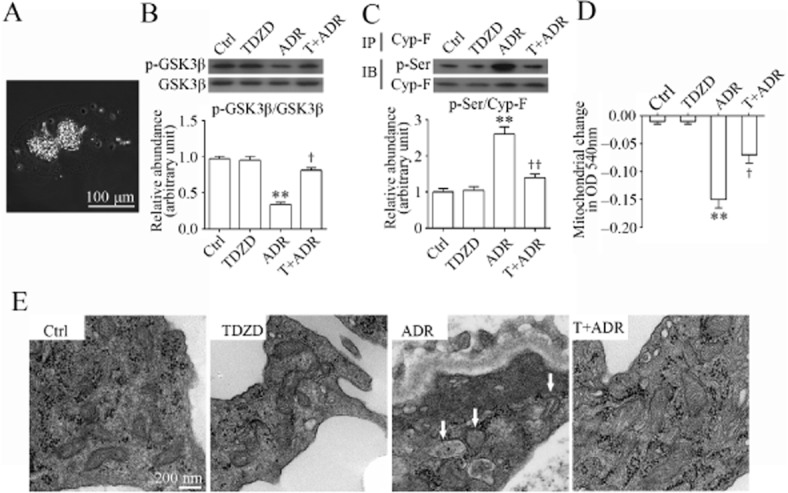Figure 7.

TDZD-8 counteracts GSK3β overactivity, prevents Cyp-F hyperphosphorylation and attenuates MPT and mitochondrial damages in podocytes in adriamycin-injured kidneys. (A) A representative micrograph showing glomeruli, isolated from kidneys by use of the magnetic beads-based approach. (B) Homogenates of glomeruli isolated from the differently-treated animals on day 14 were subjected to immunoblot analysis of phosphorylated GSK3β and total GSK3β. Densitometric analysis of immunoblots estimated the relative abundance of phosphorylated GSK3β in glomeruli from the differently-treated mice. **P < 0.01 versus Ctrl; †P < 0.05 versus ADR; (n = 15). (C) Homogenates of glomeruli isolated from the differently-treated animals on day 14 were subjected to immunoprecipitation by an anti-Cyp-F antibody, and immunoprecipitates were probed for Cyp-F or p-serine (p-Ser). Densitometric analysis of immunoblots demonstrated the relative abundance of phosphorylated Cyp-F in glomeruli from the differently- treated mice measured as densitometric ratios of phosphorylated serine and Cyp-F and expressed as fold of the control group. **P < 0.01 versus Ctrl; ††P < 0.01 versus adriamycin; (n = 15). (D) Mitochondria were extracted from glomeruli freshly isolated from the differently-treated animals on day 14. MPT was assessed by the decrease in spectrophotometric absorbance of calcium-challenged mitochondria at 540 nm. **P < 0.01 versus Ctrl; †P < 0.05 versus ADR; (n = 15). (E) Kidney cortex tissues were obtained from the differently-treated animals on day 14 and prepared for electron microscopy. Representative electron micrographs of glomerulus demonstrated severe mitochondrial damage in podocytes in adriamycin-injured mice kidneys (indicated by arrows), defined as decreased total mitochondrial numbers, mitochondrial swelling and fragmentation, destruction of the inner mitochondrial membrane, and disruption of mitochondrial cristae. This ADR-induced mitochondrial injury was significantly attenuated by TDZD-8 treatment.
